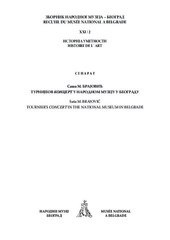Приказ основних података о документу
Турнијеов 'Концерт' у Народном музеју у Београду
Tournier’s Concert in the National Museum in Belgrade
| dc.creator | Брајовић, Саша | |
| dc.date.accessioned | 2023-05-25T10:03:58Z | |
| dc.date.available | 2023-05-25T10:03:58Z | |
| dc.date.issued | 2014 | |
| dc.identifier.issn | 0522-8352 | |
| dc.identifier.issn | 0352-2466 | |
| dc.identifier.uri | http://reff.f.bg.ac.rs/handle/123456789/4488 | |
| dc.description.abstract | Први део рада посвећен слици Концерт (уље на платну, 121,5 × 169,8 cm) француског уметника Николе Турнијеа прати њену судбину од настанка у Риму, отприлике 1626, до епилога 1949. године у Народном музеју у Београду, и изучава њено место у литератури друге половине 20. века. Потом се Концерт разматра у оквиру опуса француског каравађисте и, посебно, тзв. Manfrediana Methodus-а. Анализа стила и духа слике указује на то да Концерт, више од свих Турнијеових римских слика, изражава најјачи отклон од Манфредијевог метода. Томе у прилог највише говори специфичан начин презентовања теме слике – музике, којем је посвећен закључни део рада. Концерт се сагледава као изданак римске барокне музичке културе. Наглашава се његова аутономност у односу на уобичајене каравађескне кафанске сцене са музицирањем, јер приказује деликатно извођење музике и пажљиво слушање. Префињеност укупног израза, покрети тела и усмереност погледа протагониста, распростирање светлости, начин на који су насликани инструменти доприносе осећању складног, интимног музицирања. Нарочита пажња поклања се улози певачице и гитаристкиње која је самосвојна женска фигура у целокупном Турнијеовом опусу, као и оновременом европском сликарству профаног садржаја. Емоционална изражајност Концерта тумачи се као израз барокне визуелне културе која тежи покретању страсти душе код посматрача, а у овом случају, и посматрача и слушаоца. Аранжман композиције и фигура, токови светла и музике трансформишу посматрача/слушаоца од пасивног рецепијента у активног партиципијента визуелне и музичке креације. | sr |
| dc.description.abstract | The text is dedicated to the painting Concert (oil on canvas, 121.5 × 169.8 cm) by French artist Nicolas Tournier, which is kept in the National Museum in Belgrade. The inscriptions, stickers and stamps on the back of the painting have made it possible, in part, to reconstruct the history of the painting from its creation in Rome around 1626, to the epilogue in the National Museum in Belgrade, in 1949. Like other paintings by Tournier, the Concert had long been considered a work by Michelangelo Merisi da Caravaggio or, more precisely, by a disciple of his. That is why the paper considers the position of the painting in the literature of the second half of the 20th century, the period in which knowledge about the caravaggisti steadily grew. The Concert is then considered within the framework of the opus of the French caravaggist and, particularly, the so-called Manfrediana Methodus. The analysis of the style, spirit and atmosphere of the painting shows that the Concert, more than all other works by Tournier, expresses the most marked digression from the manner established by the painter Bartolomeo Manfredi. Highly indicative of this is the specific method of presenting the theme of the painting – music. The Concert is viewed in the context of the baroque music culture in Rome, the patronage mechanism that secured its popularity, and the method of its visualisation. The autonomy of the Concert from the usual caravaggessque tavern scene with the playing of music is emphasised because it depicts the delicate playing of music and attentive listening. The sophistication of the overall expression of this painting, the body movements and the direction in which the eyes of the figures are focused, the spreading of light, the way in which the instruments are painted, round off the feeling of the harmonious, intimate playing of music. In this improvised basso continuo, which is formed by the lute, the violin and the guitar, particular attention is paid to the role of the singer and guitar player. Judging by the appearance and the way in which she sings and plays, she is an autonomous female figure in the entire opus of Tournier and in the European profane painting of that time. The emotional expressiveness of the Concert is interpreted as the expression of baroque visual culture which strives to move the passion of the soul (muovere l’affetto dell’animo) of the observer or, in this case, both the observer and the listener. The arrangement of the composition and of the figures, the flow of light and music, transform the observer/listener from a passive recipient to an active participant of the visual and musical creation. He becomes a part of the ordinary, spontaneous, everyday world and music playing, but also of the deliberated and noble allegory of passion and suffering that love brings. | sr |
| dc.language.iso | sr | sr |
| dc.publisher | Народни музеј у Београду | sr |
| dc.relation | info:eu-repo/grantAgreement/MESTD/Basic Research (BR or ON)/177001/RS// | sr |
| dc.rights | openAccess | sr |
| dc.source | Зборник Народног музеја | sr |
| dc.subject | listener | sr |
| dc.subject | painting music | sr |
| dc.subject | music | sr |
| dc.subject | (French) caravaggisti | sr |
| dc.subject | Manfrediana Methodus | sr |
| dc.subject | baroque | sr |
| dc.subject | Rome | sr |
| dc.subject | National Museum in Belgradе | sr |
| dc.subject | Nicolas Tournier | sr |
| dc.title | Турнијеов 'Концерт' у Народном музеју у Београду | sr |
| dc.title | Tournier’s Concert in the National Museum in Belgrade | sr |
| dc.type | article | sr |
| dc.rights.license | ARR | sr |
| dc.rights.holder | Народни музеј у Београду | sr |
| dc.citation.epage | 135 | |
| dc.citation.spage | 105 | |
| dc.citation.volume | 21 | |
| dc.identifier.fulltext | http://reff.f.bg.ac.rs/bitstream/id/11056/bitstream_11056.pdf | |
| dc.identifier.rcub | https://hdl.handle.net/21.15107/rcub_reff_4488 | |
| dc.type.version | publishedVersion | sr |
| dc.identifier.cobiss | 5042447 |

